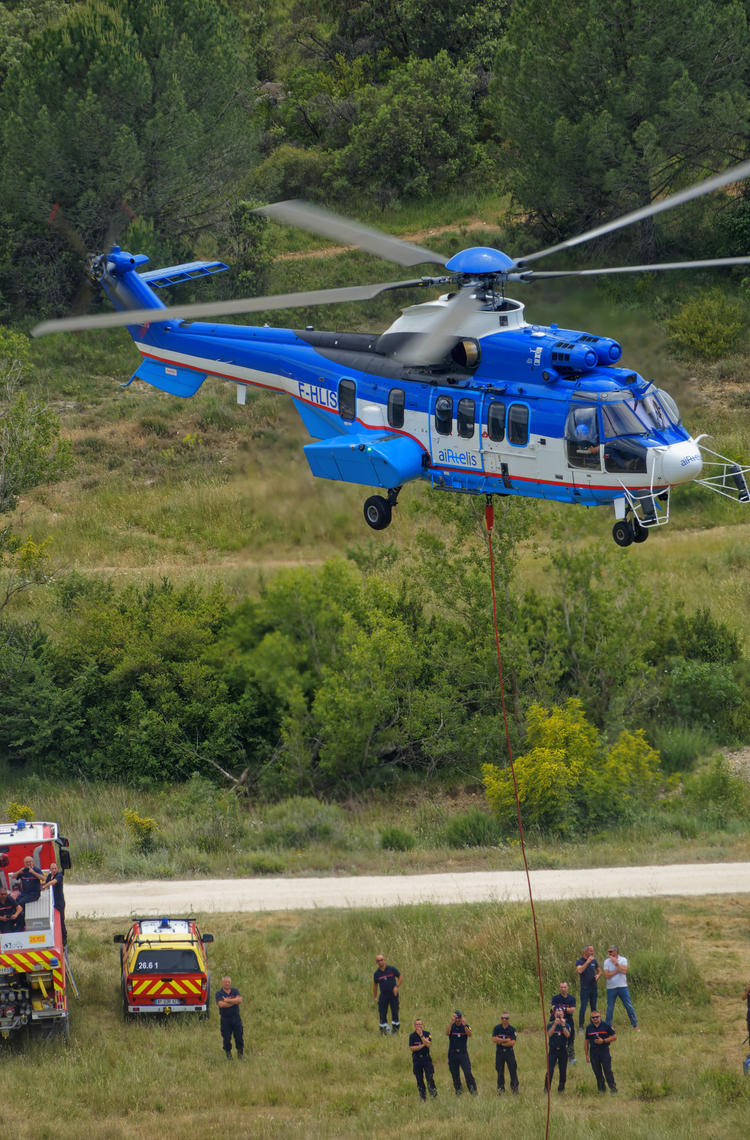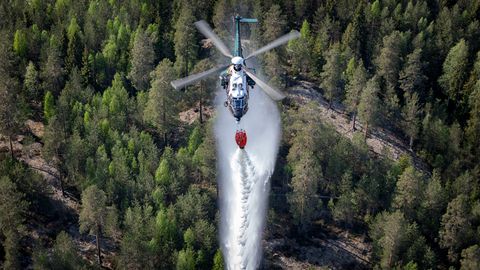With the fire season starting in Latin America and the lessons learned from the past few months in the Northern hemisphere, our helicopters are more mobilised than ever. They play an essential role in fighting fires, as they save lives and go where nothing else can. But how exactly does the Airbus Helicopters range contribute to this essential mission?
Equipped to tackle the blaze
It comes as no surprise that helicopters form an essential part of the assets available to firefighters when they reach the core phase of their operations: fire attack. From the light single helicopter family to our medium-heavy workhorses, customers can rely on multiple Airbus helicopters to help them fight fires in all conditions. Water-bombing helicopters, equipped with a flexible bucket or a belly tank, will contain the fire, slow its progress and help extinguish it by dropping up to 4,000 L of water each time they fly over the fire. For instance, the H125 can drop up to 1,200L of water each time it flies over the scene. It can transport up to four firefighters with their equipment.
The H215 also exemplifies this ability, with its rugged design, excellent payload performance, cost efficiency and demonstrated capabilities in the most demanding conditions. Xavi Vilaró, CEO of Chilean firefighting specialist Air Lama, explains: "In the heavy helicopter segment, the H215 clearly leads the field in terms of the number of firefighters it can carry and its 4000-litre water discharge capacity. It also has the longest range in its category. Our customer, the Chilean National Forest Corporation (CONAF) is more than satisfied." As the fire season is picking up in the region, four additional AS332 helicopters have been awarded by the CONAF, bringing the available fleet to seven rotorcraft in Chile.
First on the scene for life-saving operations
However, the role of helicopters in firefighting is not limited to fire attack. Not only do helicopters support firefighters during the fire attack phase of their mission, they also intervene before and after this crucial step. For instance, patrol and surveillance are key parts of firefighters’ work to assess the complexity and intensity of the fire they will have to extinguish. With its unrivalled performance in high and hot conditions, the H125 is an important asset at this point in the mission. It can also be mobilised through its high versatility and manoeuvrability, including for surveillance and passenger transport.
Evacuation represents a challenge in firefighting operations, whether to extract citizens from an endangered area in a search and rescue configuration or to protect and evacuate firefighters from the scene. Both the H145 and H225 have a high advantage in this phase of the mission. As the market leader in the EMS segment, the H145 is a trusted partner when rescuers intervene in the first “Golden hour”. Additionally, our H225 is an equally important asset for the evacuation of firefighters, with its high payload and proven winch capabilities. From observation to detect any fire that may be starting, to driving the rescue and reconstruction effort after a fire has hit, helicopters perform life-saving operations throughout firefighting missions.
Always connected and ready to deploy
Helicopters have multiple advantages for firefighting missions, one of them being of course an improved access to water sources nearby and that only a helicopter could exploit, such as rivers, pools, or even a firefighter's base. But beyond this, when intervening to fight fires, helicopters are part of an entire network that involves multiple actors and products. Interconnectivity is a major contributor to the success of firefighters’ mission in this disaster management ecosystem, which our rotorcraft excel at integrating through their high adaptability. Precise communication between aerial assets such as other helicopters, fixed-wing aircraft or drones, helps firefighters evaluate the risk of a fire starting in the area as well as determine the exact location where they need to intervene. Helicopters are also key to enable aerial command and control and establish a clear operational process for all actors mobilised.
Beyond coordination in the air, it is also essential to preserve a close link to ground systems. The information flow directed from air to ground is paramount to enable the teams on the ground to act as efficiently and safely as possible. Through improved cockpit layouts and visibility, as well as new generation features such as infrared cameras and laser distance measurement, our helicopters support firefighters to access real-time situational assessment and tracking. As a result, on the ground and in the air, firefighting missions rely on a continuously integrated, multi-asset approach that has never been more required. The recent increase in wildfires the globe over has shown that Airbus helicopters’ proven flight capabilities in all weather conditions are a must and that night flights are set to become a new normal for firefighters. Improved avionics, automated flight features and increased interoperability remain amongst our key drivers to address this challenge and make a difference in these life-saving missions.






